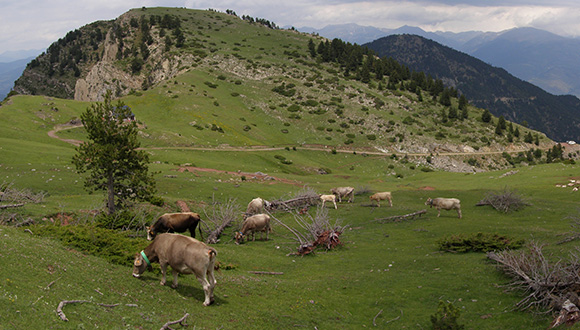Changes in traditional livestock farming in the Pyrenees have led to forest expansion
This finding is described in an article including CREAF researchers and coauthors Aitor Ameztegui and Lluís Brotons. The study addresses how the superior limit of forest cover in the Pyrenees has changed over 50 years. According to the study, the tree line has advanced upward an average of 40 meters, one of the main causes of this being decreasing pressures from livestock. Contrary to common thinking to date, climate change may play a much lesser role than previously thought.

Forests are dynamic: they can gain area, lose area, or maintain an equilibrium. In order to understand the variables which influence such dynamics, Aitor Améztugui and his team studied the tree line in the Catalonian Pyrenees between 1956 and 2006. According to the researchers, there were two important factors playing an important role in the advance or retreat of the tree line: changes in land use (abandonment of land and traditional practices due to rural flight) and climate change.
The study was undertaken by researchers from the Catalonia Forest Technology Centre (CTFC), CREAF, the University of Barcelona and the CSIC, and has been published this month in the journal Global Ecology and Biogeography, whose cover for the same issue features a photograph of the Pyrenees by the authors.
The results show that the forest cover has advanced an average of 40 meters.
Forest advance proved to be quite variable in the study, since more than 60% percent of the time no changes were seen.
The areas with the greatest increases in the forest edge are those which have undergone a notable change in land use. Fifty years ago there were greater impacts of domesticated animals, both in terms of number and also the presence of sheep in transhumance, a system of continuous movement to different pastures which kept the forest at bay. Today, this pressure of domesticated animals has been reduced and it easier to see herds of cattle whose impact on the surroundings is lower.
On the other hand, the study did not find any evidence to relate changes in the tree line with temperature increases. This result is very relevant since the tree line is typically very influenced by climate, for which reason a future increase in the tree line might be expected. Nevertheless, Ameztegui clarifies that “it’s not that climate doesn’t play a role, but compared with changes in land use the effect is much smaller”.
There is still room for forest expansion
The tree line is the limit of tree growth. In the Catalonian Pyrenees, this limit is found at approximately between 2000 and 2300 meters. At this altitude there is a transition between a subalpine climate, dominated by forests of black pine, and an alpine climate, with vegetation limited to shrubs and herbaceous plants.
If it weren’t for human disturbances, the tree line could increase to between 2200 and 2500 meters.
The increase in the tree line is just another result of abandonment of traditional farming and livestock practices, which also contribute to forest densification and expansion. The loss of open spaces and the typical mosaic of the mountain forest landscape, characterized by the combination of forests and pastures, could have important effects on biodiversity, causing displacements of species which are characteristic to open environments, or favoring others which prefer forested habitats. In any case, Ameztegui clarifies that Pyrenean forests, “still have room for growth because pressures from livestock farming are still determining the edge of the forest”.
More information in:
Aitor Ameztegui, Lluís Coll, Lluís Brotons and Josep M. Ninot. Land-use legacies rather than climate change are driving the recent upward shift of the mountain tree line in the Pyrenees. (2015) Global Ecology and Biogeography. DOI: 10.1111/geb.12407






